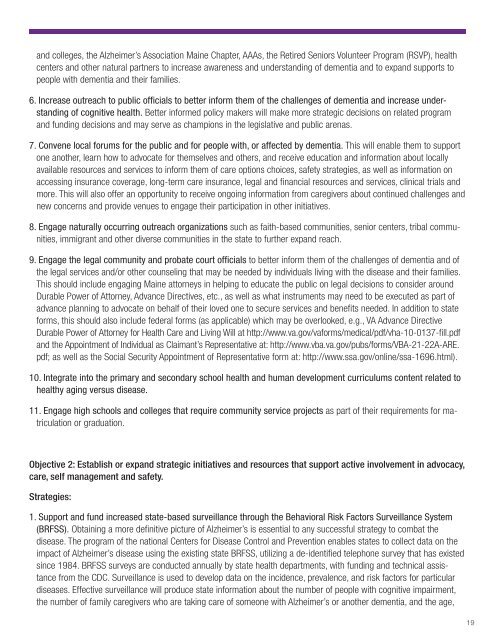State Plan for Alzheimer’s Disease and Related Dementias in Maine
State Plan for Alzheimer’s Disease and Related Dementias in Maine
State Plan for Alzheimer’s Disease and Related Dementias in Maine
You also want an ePaper? Increase the reach of your titles
YUMPU automatically turns print PDFs into web optimized ePapers that Google loves.
<strong>and</strong> colleges, the <strong>Alzheimer’s</strong> Association Ma<strong>in</strong>e Chapter, AAAs, the Retired Seniors Volunteer Program (RSVP), health<br />
centers <strong>and</strong> other natural partners to <strong>in</strong>crease awareness <strong>and</strong> underst<strong>and</strong><strong>in</strong>g of dementia <strong>and</strong> to exp<strong>and</strong> supports to<br />
people with dementia <strong>and</strong> their families.<br />
6. Increase outreach to public officials to better <strong>in</strong><strong>for</strong>m them of the challenges of dementia <strong>and</strong> <strong>in</strong>crease underst<strong>and</strong><strong>in</strong>g<br />
of cognitive health. Better <strong>in</strong><strong>for</strong>med policy makers will make more strategic decisions on related program<br />
<strong>and</strong> fund<strong>in</strong>g decisions <strong>and</strong> may serve as champions <strong>in</strong> the legislative <strong>and</strong> public arenas.<br />
7. Convene local <strong>for</strong>ums <strong>for</strong> the public <strong>and</strong> <strong>for</strong> people with, or affected by dementia. This will enable them to support<br />
one another, learn how to advocate <strong>for</strong> themselves <strong>and</strong> others, <strong>and</strong> receive education <strong>and</strong> <strong>in</strong><strong>for</strong>mation about locally<br />
available resources <strong>and</strong> services to <strong>in</strong><strong>for</strong>m them of care options choices, safety strategies, as well as <strong>in</strong><strong>for</strong>mation on<br />
access<strong>in</strong>g <strong>in</strong>surance coverage, long-term care <strong>in</strong>surance, legal <strong>and</strong> f<strong>in</strong>ancial resources <strong>and</strong> services, cl<strong>in</strong>ical trials <strong>and</strong><br />
more. This will also offer an opportunity to receive ongo<strong>in</strong>g <strong>in</strong><strong>for</strong>mation from caregivers about cont<strong>in</strong>ued challenges <strong>and</strong><br />
new concerns <strong>and</strong> provide venues to engage their participation <strong>in</strong> other <strong>in</strong>itiatives.<br />
8. Engage naturally occurr<strong>in</strong>g outreach organizations such as faith-based communities, senior centers, tribal communities,<br />
immigrant <strong>and</strong> other diverse communities <strong>in</strong> the state to further exp<strong>and</strong> reach.<br />
9. Engage the legal community <strong>and</strong> probate court officials to better <strong>in</strong><strong>for</strong>m them of the challenges of dementia <strong>and</strong> of<br />
the legal services <strong>and</strong>/or other counsel<strong>in</strong>g that may be needed by <strong>in</strong>dividuals liv<strong>in</strong>g with the disease <strong>and</strong> their families.<br />
This should <strong>in</strong>clude engag<strong>in</strong>g Ma<strong>in</strong>e attorneys <strong>in</strong> help<strong>in</strong>g to educate the public on legal decisions to consider around<br />
Durable Power of Attorney, Advance Directives, etc., as well as what <strong>in</strong>struments may need to be executed as part of<br />
advance plann<strong>in</strong>g to advocate on behalf of their loved one to secure services <strong>and</strong> benefits needed. In addition to state<br />
<strong>for</strong>ms, this should also <strong>in</strong>clude federal <strong>for</strong>ms (as applicable) which may be overlooked, e.g., VA Advance Directive<br />
Durable Power of Attorney <strong>for</strong> Health Care <strong>and</strong> Liv<strong>in</strong>g Will at http://www.va.gov/va<strong>for</strong>ms/medical/pdf/vha-10-0137-fill.pdf<br />
<strong>and</strong> the Appo<strong>in</strong>tment of Individual as Claimant’s Representative at: http://www.vba.va.gov/pubs/<strong>for</strong>ms/VBA-21-22A-ARE.<br />
pdf; as well as the Social Security Appo<strong>in</strong>tment of Representative <strong>for</strong>m at: http://www.ssa.gov/onl<strong>in</strong>e/ssa-1696.html).<br />
10. Integrate <strong>in</strong>to the primary <strong>and</strong> secondary school health <strong>and</strong> human development curriculums content related to<br />
healthy ag<strong>in</strong>g versus disease.<br />
11. Engage high schools <strong>and</strong> colleges that require community service projects as part of their requirements <strong>for</strong> matriculation<br />
or graduation.<br />
Objective 2: Establish or exp<strong>and</strong> strategic <strong>in</strong>itiatives <strong>and</strong> resources that support active <strong>in</strong>volvement <strong>in</strong> advocacy,<br />
care, self management <strong>and</strong> safety.<br />
Strategies:<br />
1. Support <strong>and</strong> fund <strong>in</strong>creased state-based surveillance through the Behavioral Risk Factors Surveillance System<br />
(BRFSS). Obta<strong>in</strong><strong>in</strong>g a more def<strong>in</strong>itive picture of <strong>Alzheimer’s</strong> is essential to any successful strategy to combat the<br />
disease. The program of the national Centers <strong>for</strong> <strong>Disease</strong> Control <strong>and</strong> Prevention enables states to collect data on the<br />
impact of <strong>Alzheimer’s</strong> disease us<strong>in</strong>g the exist<strong>in</strong>g state BRFSS, utiliz<strong>in</strong>g a de-identified telephone survey that has existed<br />
s<strong>in</strong>ce 1984. BRFSS surveys are conducted annually by state health departments, with fund<strong>in</strong>g <strong>and</strong> technical assistance<br />
from the CDC. Surveillance is used to develop data on the <strong>in</strong>cidence, prevalence, <strong>and</strong> risk factors <strong>for</strong> particular<br />
diseases. Effective surveillance will produce state <strong>in</strong><strong>for</strong>mation about the number of people with cognitive impairment,<br />
the number of family caregivers who are tak<strong>in</strong>g care of someone with <strong>Alzheimer’s</strong> or another dementia, <strong>and</strong> the age,<br />
19


